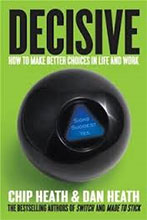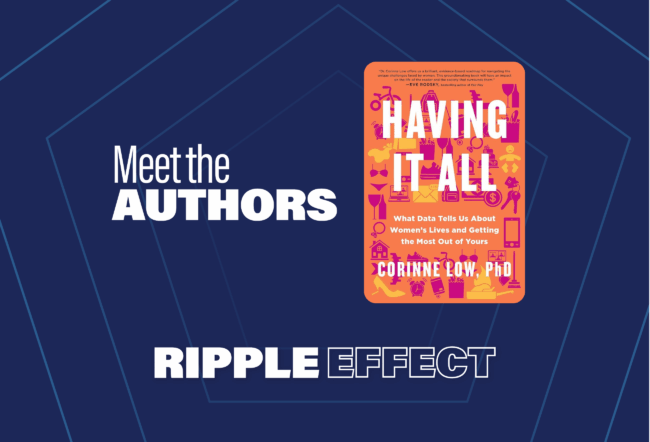In Decisive: How to Make Better Choices in Life and Work, bestselling authors Chip Heath and Dan Heath argue that humans don’t have a particularly strong track record of making good choices — whether it is about our careers, business matters or our personal lives. In their book, they explore the common decision-making traps we fall into and how to overcome them to make better decisions. Knowledge at Wharton recently had an opportunity to talk with Chip about how widening your options, reality-testing your assumptions, attaining distance before deciding and preparing to be wrong can make all the difference.
An edited transcript of the conversation follows.
Knowledge at Wharton: Chip, thank you for joining Knowledge at Wharton to discuss your new book Decisive, co-authored with Dan Heath. Many of us think we are being analytical and thoughtful when we make decisions, yet the book argues we are far from rational and frequently set ourselves up to make poor decisions. Where are we going wrong?
Chip Heath: There’s a whole literature in psychology that has emerged over the last 30 years that has talked about various ways that we go wrong. One way that we go wrong, for example, is what psychologists call “confirmation bias.” We’ll start with an idea about what’s going to happen in a situation [such as] “I really like this job candidate” or “I really think this merger is a good idea.” We collect information, but we have our thumbs on the scale. If we think we’re going to like the job candidate or the merger, we collect information in a way that biases, in subtle and not-so-subtle ways, the conclusion toward that initial reaction.
That’s just one example of probably 30 different things that psychologists have discovered that creep in as flaws in decision processes. What we tried to do in Decisive is to think about how we would start fixing some of these problems.
Knowledge at Wharton: Right. The book breaks down four steps in the decision-making process. What are those steps?
Heath: The first step of the process is widening your options. Psychologists have found that very often when we are considering a decision, we are essentially thinking thumbs up [or] thumbs down on one alternative. [For example,] I have a problem with somebody in my office, a subordinate. I’m thinking, “Should I fire the person or not?” Very often it’s easy for a mind to lock into one alternative when we should be considering, “Well, could we move them to a different assignment? Could we get them some mentoring?” There are lots of things that we should be considering but our minds tend to focus on one option.
We talk about reality testing our ideas. Confirmation bias, which we mentioned earlier, gets in the way of collecting information and getting at the reality of the situation.
At the moment we’re choosing, it helps us attain some distance on the choice and take a broader perspective because very often we get locked into the weeds of a decision and find it agonizing to make a choice between two good alternatives. But what we’re not thinking about necessarily is the broader picture of where we want to go as an individual or where, as a business person, we want our company to go.
Finally, even after we have made a decision, there are things that we can do to take out little forms of insurance so that if something goes bad we’re going to be more prepared for that. We talk about “preparing to be wrong.” Our view of the future is not always perfect. If it’s not always perfect, then we might as well have contingency plans. We don’t always have those because we get over-confident about our picture of the future.
Knowledge at Wharton: In terms of widening our options, how are some organizations using multi-tracking as a solution? Also, how can others apply this concept without adding on a hefty price tag?
Heath: Multi-tracking essentially says that we do better if we consider two or three alternatives at the same time. There was a study in Silicon Valley by Kathy Eisenhardt at Stanford University. She found the Silicon Valley firms that were the quickest to respond to strategic changes — and respond with a strategy that addressed the changes in their industry — were firms where top leaders considered multiple alternatives at the same time. By considering two or three at once, by multi-tracking, you’re in better shape than if you consider one alternative, and then if that one fails, you go onto the next one and then the next one. In both cases you might consider three alternatives, but if you’re doing them at the same time you get a better sense of the lay of the land, of the dimensions in which alternatives vary. You are more likely not to escalate commitment in response to a bad decision — throwing more time and money after a failing project — because you go with your second alternative that you were considering at the same time.
This notion that there’s a strong trade-off between considering more and the costs turns out to be less well supported by the research than we might have expected. You’re actually faster, Kathy Eisenhardt says in her data, if you’re considering multiple options, because you don’t get locked into bad courses of action.
Knowledge at Wharton: Another tactic you recommend is finding someone who’s solved your problem already. Can you give us an example of how one would approach that?
Heath: That’s one of the things that Dan and I found the most useful. Any time we confront a problem, we are probably not the first people in humanity to ever deal with that problem. Yet very often we feel it’s incumbent on us to come up with our solutions to the problem. A junior high school principal who is trying to get kids through the lunch line faster so that they have more time to actually get out and play at recess and work out their bodies could consult other junior high school principals about the problem. That’s what we typically do. We look to other people who are very much like us.
But what the principal may not have thought about is there may be a lot of business owners who have problems with queuing in their restaurants or their stores. He might be able to learn from them. He might be able to learn from sports stadiums and looking at the design principles of those. Back to the widening your options idea, very often we get locked into a fairly narrow set of people and ideas that we consult. We consult people in our company on our floor, as opposed to consulting people in the broader industry or even consulting people in other industries that face similar problems.
Knowledge at Wharton: That’s very helpful. For many, I think it’s challenging to think of considering the very opposite of our assumptions. What would be involved in considering the opposite and what are the gains?
Heath: This addresses the point about reality testing our assumptions. Confirmation bias creeps in and says, “We really like this person that we are interviewing.” Our tendency is to look for the positive aspects of their resume or their experiences or the strength that they would bring to the organization. But it’s also worthwhile when we’re hiring somebody to think, “Why would this person not be the right fit for the job? Why would they not have the right skills?” Very often, that highlights some information that we wouldn’t have thought about otherwise. The basic principle of considering the opposite is that in a world where we are plagued with confirmation bias, very often we will consciously think to ourselves, “I really like this idea for a merger. The company seems really good. It seems like a really good fit.” But consciously, we must remind ourselves to ask, “Why would this not be a good merger?”
With Daimler and Chrysler, there were lots of reasons that the merger should have worked: the great engineering of Mercedes and the marketing savvy of Chrysler. But what they should have asked is, “Why would this merger not work?” It turns out when you get the obsessive engineers of Daimler and the wild innovative marketers at Chrysler, they don’t always get along very well. I think if they had asked the disconfirming questions earlier, they would have been in a better position to manage that merger if they had decided to do it, or maybe [have decided] to not do the merger in the first place.
Knowledge at Wharton: You also recommend getting some distance before deciding. What if that’s not possible?
Heath: It’s almost always possible to get some distance. When we’re choosing between two options the advice that we get is, “Well, why don’t you sleep on it?” Essentially that’s a way for us to get some mental distance from an agonizing struggle that we may be having between, “Should we purchase this or that?” or “Should we do this career option as opposed to that career option?” Business writer Suzy Welch has a procedure she calls “10-10-10”: Think about this decision 10 minutes from now, 10 months from now and 10 years from now. What are the implications at those three different time scales?
What’s brilliant about that is [the impact] when we get lost in the weeds of a decision: We may have a problem with someone on our team who’s not contributing a lot. Ten minutes from now, that seems like an awful conversation to have. We dread those conversations. But ten months from now, it would be really nice to have this resolved. Maybe the person will decide to move on to something else, but in either case they are going to be a better functioning member of the team or they are going to be off on some other task. Ten years from now, none of this may matter. All of us will be at a different part of their career.
By looking at those different time scales, by getting some mental temporal distance from the agony that we are facing, we are more likely to have the difficult conversation and we are more likely to make the right choice in that situation.
Knowledge at Wharton: For a final question, even with the best of decision-making processes, how can business leaders prepare for the inevitable wrong decision?
Heath: Preparing to be wrong is just admitting with some humility that we don’t have the future nailed. We often have a very precise estimate of what the future is going to bring. But there are studies of doctors that say that when a doctor expresses complete certainty that a diagnosis is correct, they could be wrong up to 40% of the time. If even a well-trained professional making a decision in their area is wrong a substantial portion of the time, then maybe we ought to take out some insurance on that.
In the case of the medical decision, we would get a second opinion. In the case of a business decision where we’re introducing a new product, make a decision upfront to set a trip wire and say, “If we don’t achieve a market penetration of at least 7% in this test market, we want to re-evaluate whether this is the right product. We want to re-evaluate whether we’ve got the right formulation of the product, and maybe abandon the product in the first place.” But what we don’t want … is a situation … where we are throwing good money after bad because we haven’t considered the possibility that things might not go as well as we thought.



